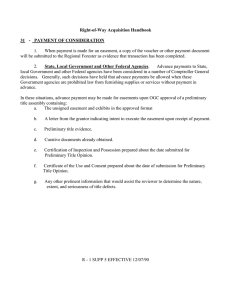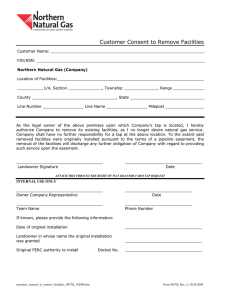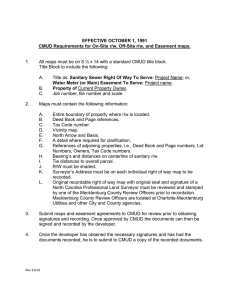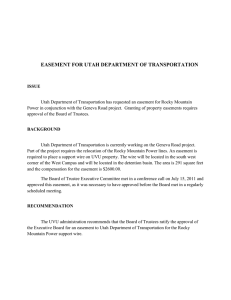Tax Treatment of Damages and Easements in Oil and Gas Operations
advertisement
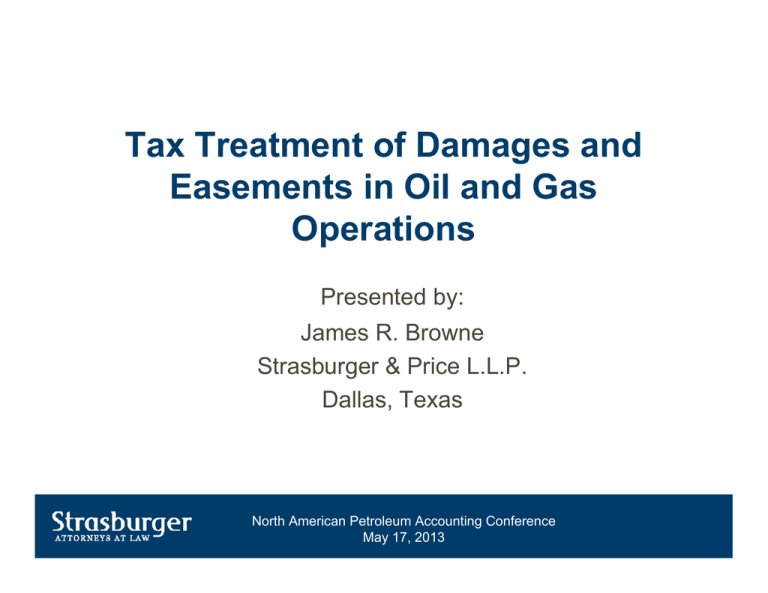
Tax Treatment of Damages and Easements in Oil and Gas Operations Presented by: James R. Browne Strasburger & Price L.L.P. Dallas, Texas North American Petroleum Accounting Conference May 17, 2013 Speaker JAMES R. BROWNE Jim is a partner in the Dallas office of Strasburger & Price, LLP law firm, specializing in general tax planning. He has over 30 years of experience in the area of taxation, having served as lead counsel in matters involving federal, state, and foreign taxes. He regularly advises clients on the U.S. income tax aspects of domestic and international business transactions involving a diverse range of industries, including healthcare, manufacturing, energy, real estate, and financial services. Strasburger & Price, LLP 901 Main Street, Suite 4400 Dallas, Texas 75202.3794 Tel: 214.651.4420 Fax: 214.659.4019 jim.browne@strasburger.com Prior to joining Strasburger in 2005, Mr. Browne served as chief tax officer for several large publicly traded multinational companies, was a partner in a "Big 4" accounting firm, and was a partner in a nationally prominent law firm. He earned his law degree from Vanderbilt University (1981) and his undergraduate degree in business administration from the University of Michigan (1978). He is a licensed lawyer and certified public accountant in Texas. Strasburger & Price, a full-service law firm with seven offices, is one of Texas’ largest and most respected firms. Strasburger serves as a trusted adviser to publicly and privately held companies, entrepreneurs, executives, governmental entities and individuals. Since the firm’s founding in 1939, Strasburger attorneys have been privileged to represent more than half of the Fortune 500 companies. For more information, visit www.strasburger.com. North American Petroleum Accounting Conference May 17, 2013 2 Agenda • Property damages: examples and general tax rules • Easements: examples and general tax rules • Gilbertz case • Related tax issues • Information reporting for damages North American Petroleum Accounting Conference May 17, 2013 3 Damages • General Rule – Working interest owner has dominant right to enter land to explore for, produce, and transport minerals – The working interest owner’s surface use rights are very broad, but are increasingly being limited by contract or by local laws – The lessee is generally liable only for damages from negligent, unreasonable, or excessive operations • May be modified by contract or by local law • Strict liability for some acts (pollution) – Obligation to restore lands at termination of lease varies by jurisdiction North American Petroleum Accounting Conference May 17, 2013 4 Damages • Surface Damage Acts – Intended to protect agricultural and ranching uses from disruption by oil and gas operations – Impose strict liability for surface damages (surface owner need not prove negligence or unreasonable operations) – Encourage negotiated advance payments for damages and release of claims • Right to Recovery – Can be provided by contract (including advance payments and liquidated damages); or – Recovered through judicial action for violation of statute or for negligent, unreasonable, or excessive operations North American Petroleum Accounting Conference May 17, 2013 5 Damages • Examples – Damage to land (natural vegetation and land features) – Damage to or unauthorized depletion of water supply – Damage to crops and timber – Damage to personal property and improvements • Livestock • Fences, equipment, and structures – Lost profits from loss of use of land or disruption of surface operations – Unauthorized use or damage to surrounding surface areas – Nuisance North American Petroleum Accounting Conference May 17, 2013 6 Damages • Sample Texas lease provision: – “Lessee shall, upon termination of this Agreement, remove all of Lessee's equipment, fill and level all pits, and restore the surface. … Lessee shall pay for all damages resulting from operations under this Agreement to the lands, including trees, fences, crops, pasture, native or cultivated grass, improvements, or to any other structures, or to any agents or invitees of Lessor. Lessee’s liability shall exist whether or not damage is due to negligence of lessee or its agents or invitees, and whether or not the operations under this Agreement are reasonable and not excessive.” – Alternatively, the contract might specify amounts to be paid at inception or annually, or both, for “anticipated use of or damage to the surface estate,” and include a waiver of landowner claims for actual damages (other than damages from negligent, unreasonable, or excessive operations). North American Petroleum Accounting Conference May 17, 2013 7 Damages • Tax Issues – Payee’s tax consequences from receipt of damage payment • Ordinary income, or return of basis/capital gain? • If return of basis, allocation of basis – Payor’s tax consequences • Deduct or capitalize? • If capitalize, cost recovery period North American Petroleum Accounting Conference May 17, 2013 8 Payee Tax Consequences • Payment for damage to property = recovery of capital – Any payment in excess of basis is sale or exchange gain – Taxpayer must allocate basis to damaged property unless it is impossible or impractical to do so (e.g., because damage affects the entire property or an indeterminate portion) Rev. Rul. 68-291 • Payment for use of property = ordinary income • Payment for lost profits = ordinary income • In the typical fact pattern, the IRS is arguing for ordinary income treatment and the taxpayer has the burden of proving otherwise North American Petroleum Accounting Conference May 17, 2013 9 Payor Tax Consequences • Operators – Incurred prior to lease acquisition (e.g., shooting seismic) = amortizable geological and geophysical (G&G) – Incurred after lease acquisition incident to drilling of wells and preparing wells for the production of oil and gas = intangible drilling cost (IDC) – Incurred after lease acquisition incident to operation of completed wells = operating costs – Incurred after lease acquisition incident to production equipment or structures having a salvage value (e.g., damage associated with construction of pumping station or barracks) = depreciable capital cost North American Petroleum Accounting Conference May 17, 2013 10 Payor Tax Consequences • Pipeline Companies – Payments for damages negotiated and paid at the time of the grant of the easement = included in cost of easement (amortizable section 197 intangible) Rev. Rul. 72-403 – Incurred during construction • If paid for utilization of the easement = cost of easement Tenneco, Inc. v. United States, 433 F.2d 1345 (5th Cir. 1970) • Otherwise = depreciable pipeline construction costs – Incurred during operation • Generally = operating cost Rev. Rul. 94-38 (pollution) • If paid for utilization of the easement and contemplated at inception, probably treated as cost of easement North American Petroleum Accounting Conference May 17, 2013 11 Easements • Definition – An easement is a limited right to use land, and is granted by contract or arises by implied consent (prescription) • Comparison to damages – Damages typically flow from unauthorized use of the land – An easement may or may not involve physical damage to property or other adverse economic consequences to the grantor – Damages, by definition, always involve physical damage or other adverse economic consequences to the landowner North American Petroleum Accounting Conference May 17, 2013 12 Easements • Examples – Access for shooting seismic – Access rights to well site (roads, utilities) – Use of surface area at well site – Use of surrounding surface area for storage tanks, flow lines, equipment storage, operations – Gathering pipeline easement – Use of surrounding surface area for housing – Pipeline or utility line right of way North American Petroleum Accounting Conference May 17, 2013 13 Landowner Tax Consequences • Payment for temporary easement = rent – Examples • Easement to shoot seismic where no damage to land is expected • Easements for well drilling and operations (terminate upon exhaustion of production) Vest v. Commissioner, 481 F.2d 238 (5th Cir. 1973) – Note: although the easement is inherent in the working interest, lessees sometimes agree to pay separate consideration for an easement • Payment for permanent easement = recovery of basis – Example: transmission pipeline or utility line (term not tied to production of specific minerals or otherwise limited in time) – Applied to basis allocable to the permanent portion of the easement, unless allocation is impossible or impractical Rev. Rul. 73161 North American Petroleum Accounting Conference May 17, 2013 14 Payor Tax Consequences • General rules – Temporary easement: • Incurred prior to lease acquisition (e.g., easement to shoot seismic) = amortizable geological and geophysical (G&G) • Incurred at or after lease acquisition incident to drilling of wells and preparing wells for the production of oil and gas (e.g., access road) = intangible drilling cost (IDC) • Incurred after lease acquisition incident to production (e.g., roads for operating phase; area for flow lines, storage tanks, and production equipment and structures; and production reservoirs) = depreciable capital cost – Permanent easement: amortizable section 197 property; 15-year amortization Rev. Rul. 72-403 North American Petroleum Accounting Conference May 17, 2013 15 Gilbertz1 case 1 574 F. Supp. 177 (D. Wyo. 1983), aff’d 808 F.2d 1374 (10th Cir. 1987) North American Petroleum Accounting Conference May 17, 2013 16 Gilbertz Case • Facts – Gilbertz owns 6,400 acre cattle ranch – Federal government owns the minerals and has entered into leases with various individuals and companies – By statute, lessee has right of entry and use, but is liable to landowner for damage caused by negligence and for damage to crops and tangible improvements – Gilbertz has three types of contracts • “Release and Damage Payment” contracts with lessees • “Right of Way Easement” contracts with pipeline companies • “Surface and Damage Agreement” with a drilling company – All contracts require rehabilitation of land on termination of the activity covered by the contract North American Petroleum Accounting Conference May 17, 2013 17 Gilbertz Case • Tax Reporting – Gilbertz contends all payments are for damages to land (recovery of entire basis in ranch and then as capital gain) – IRS contends all payments are rent/ordinary income North American Petroleum Accounting Conference May 17, 2013 18 Gilbertz Case • District Court Analysis – Release and Damage Payment contracts • Key findings – Payment = compensation for damages caused by well drilling and completion and for release of claims for such damages – Excludes damages to personal property or other property – Annual payment ceases on termination of leases – Parties’ intended the payments to be in the nature of damages or for the release from liability for damages • Conclusion: payments are for damage to land and are not rent • Vest case distinguished – Vest contract was negotiated by the mineral owner (who had right to demand rent for use of land) – Vest contract called for separate payments for damages – Termination of payments on expiration of lease not dispositive North American Petroleum Accounting Conference May 17, 2013 19 Gilbertz Case • District Court Analysis (con’t) – Right of Way Easement • Key findings: – Grants a right of way easement to the pipeline company in exchange for a fixed payment – Gilbertz releases claims for damages – Parties intended an easement and advance payment for damages – Written contract recorded in property records – Easement is assignable – Perpetual even though extinguished upon abandonment • Conclusion: Contracts create an easement (interest in real property) not a license; payments are for damage to property and are not rent North American Petroleum Accounting Conference May 17, 2013 20 Gilbertz Case • District Court Analysis (con’t) – Surface and Damage Agreement • Key findings: – Grants right to build a road across Gilbertz property to access a well drilled on an adjoining property – Called an “easement” in the contract – Payment is “an advance from damages and right of way use” – Additional compensation for extraordinary losses – Agreement is recordable, but was not recorded – Expires on termination of driller’s oil and gas lease • Conclusion: Contract creates an easement. Payment = capital gain North American Petroleum Accounting Conference May 17, 2013 21 Gilbertz Case • District Court Analysis (con’t) – Apportionment of Basis • Damages and easements affected the ranch as a whole, therefore all payments applied against basis in the entire ranch, and excess treated as capital gain – Result: Taxpayer wins on all issues North American Petroleum Accounting Conference May 17, 2013 22 Gilbertz Case • 10th Circuit Analysis – Release and Damage Payment Receipt contracts • District court decision reversed; payments are ordinary income • No evidence that operations were negligent, unreasonable, or caused excessive use of surface areas (which are the only ways a lessee could be liable for damage to Gilbertzes’ land) • No evidence of actual damages to land • Evidence indicates that the payments were for loss of use of land, impact on cattle raising operations and cash crops, and resulting lost profits North American Petroleum Accounting Conference May 17, 2013 23 Gilbertz Case • 10th Circuit Analysis – Right of Way Easement • District court decision affirmed; payment is for “sale of capital asset and recovery of basis” • Gilbertz possessed the surface rights granted to the pipeline companies • Easement is perpetual despite reversion on abandonment • Evidence of permanent disruption of natural grasses and damage to grazing lands – Surface and Damage Agreement • District court decision reversed; payments are ordinary income • Easement was not perpetual; terminated when minerals exhausted North American Petroleum Accounting Conference May 17, 2013 24 Gilbertz Case • 10th Circuit Analysis (con’t) – Apportionment of Basis • District court decision reversed and remanded • Only payments for pipeline easements can be applied against basis • District court to determine portion of ranch affected by pipeline easements “and the damage to the native sod caused by construction of the pipeline” • If apportionment is impossible or impractical, District Court must enter specific findings – Result: taxpayer wins only pipeline easement issue North American Petroleum Accounting Conference May 17, 2013 25 Implications of Gilbertz Case • In most cases IRS will characterize contract payments as ordinary income • To obtain recovery of basis/capital gain, taxpayer must prove payments are for damage to property and not for use of property or lost profits – Difficult to prove (especially if lessee must repair the damage) – Advance payments: must prove actual, recoverable damage • Designation of payments in contract or settlement agreement not controlling • Allocation of basis: must prove “affected” area North American Petroleum Accounting Conference May 17, 2013 26 Related Tax Issues • Involuntary conversion (§1033) – Rev. Rul. 66-334: damages received for contamination of water supply due to seepage from salt water disposal pit are eligible for tax free reinvestment in other property similar or related in services or use (e.g., purchase of other water supply) – Same for damage to crops, timber, or livestock; reinvestment in other farm property may qualify (§1033(f)) • Casualty Loss (§165(c)(3)) – Deduction for uncompensated loss to property – Requires suddenness (e.g., gas line explosion; well blowout) – Can deduction for repair costs also be claimed? T.D. 9564 would require capitalization of repair costs (and permit an election to forego casualty loss deduction) but R.R. Hensler inc. v. Commissioner, 73 T.C. 168 (1979) and C.C.A. 199903030 are contrary. North American Petroleum Accounting Conference May 17, 2013 27 Information Reporting • Damages – Operator probably has an obligation to report payments to noncorporate payees on Form 1099-MISC (Box 3 – Other income) unless the payment is clearly non-taxable • Instructions require reporting for “taxable damages” other than payments for “replacement of capital” • Nevertheless, damage payments are often not reported to landowner – Landowner is obligated to report receipt of damage payments as income if landowner cannot establish that the payment was for damage to property • Temporary Easement = report as rent • Permanent Easement = purchase of a property interest North American Petroleum Accounting Conference May 17, 2013 28 Summary • Landowner – Damages: generally represent ordinary income unless landowner can prove compensation for actual damage to property – Easements • Temporary = ordinary income (rent) • Permanent = recovery of basis/capital gain • Operator/Pipeline Company – Damages: payment characterized by stage of development – Easements • Temporary = cost of related activity • Permanent = amortizable intangible property North American Petroleum Accounting Conference May 17, 2013 29 Disclaimer This document is not intended to provide legal, tax, or other advice as to any specific matter or factual situation, and should not be relied upon without consultation with qualified professional advisors. Any tax advice contained in this document is not intended or written to be used, and cannot be used, for the purpose of (i) avoiding penalties that may be imposed under applicable tax laws, or (ii) promoting, marketing, or recommending to another party any transaction or tax-related matter. North American Petroleum Accounting Conference May 17, 2013 30
